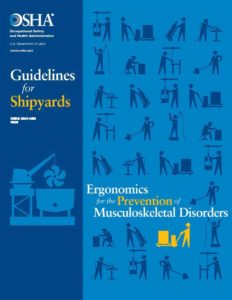 Ergonomic Guidelines for Shipyards (OSHA)
Ergonomic Guidelines for Shipyards (OSHA)
Download Booklet PDF • Welcome to our blog article Ergonomic Guidelines for Shipyards where we delve briefly into the intricacies of shipyard work environments. Shipyards are dynamic workplaces that handle a wide range of vessels, including tankers, cargo carriers, fishing vessels, military ships, and barges. These versatile facilities undertake various tasks such as new ship construction, repair, maintenance, and shipbreaking (demolition). Shipyard work involves a multitude of activities, such as fabricating and forming large steel plates, beams, and pipes, as well as conducting painting and coating operations. Additionally, there are outfitting activities like electrical work, sheet metal work, and propulsion system maintenance. Welding is also commonplace, necessitating grinding and chipping of welds.
It’s important to note that most shipyard employees work outdoors, enduring challenging conditions like extreme temperatures. The scale of shipyards can vary, with smaller ones employing fewer than one hundred individuals and larger ones boasting 5,000 employees or more. Shipyard work is divided into three categories: shop work, yard work, and ship work. Fabrication generally commences in a shop separate from the vessel, mirroring certain manufacturing or maintenance activities. However, final assembly takes place on the vessel itself, within varying and unique environments. While some repair and maintenance work can be done off the vessel, the majority must be carried out onboard.
Work-Related MSDs of Shipyard Employees
Shipyard employees may experience early indicators of musculoskeletal disorders (MSDs) such as numbness, tingling, pain, restricted joint movement, or soft tissue swelling. Research has revealed that shipyard employees frequently report persistent or recurring shoulder pain, often associated with rotator cuff tendonitis. Lower extremity MSDs, strains, sprains of the low back muscles, and related disorders are also prevalent amongst shipyard workers. Moreover, individuals who utilize vibrating tools often exhibit symptoms of hand-arm vibration syndrome, colloquially known as “vibration white finger.”
Certain MSDs can develop gradually over time due to intensive work. When employees are required to assume awkward or static body postures for prolonged periods, they may be at risk of developing MSDs. Additionally, physical demands outside the workplace can contribute to or cause MSDs. Genetic factors, gender, age, and other elements may also play a role in the development of MSDs. Significantly, reports of MSDs have been linked to certain psychosocial factors such as job dissatisfaction, monotony, and limited job control. It’s important to note that the guidelines primarily address physical risk factors within the workplace.
Ergonomic Risk Factors
Ergonomics-related risk factors prevalent among shipyard employees include force, repetition, awkward and prolonged static body postures, contact stress, vibration, and cold temperatures combined with the aforementioned risk factors. The presence of these risk factors in a job increases the likelihood of injury. However, it’s crucial to understand that the existence of these risk factors does not automatically mean that employees will develop MSDs.
The Occupational Safety and Health Administration (OSHA) has visited shipyards that have implemented ergonomic solutions, yielding significant success in reducing work-related MSDs. Creating a safer and more comfortable work environment has also resulted in additional benefits, such as decreased absenteeism, increased efficiency and productivity, decreased fatigue, and improved employee morale.
Thank you for joining us on this informative journey into shipyard work environments. Stay tuned for more insights and tips!
